September 9, 2004
Self-Sustaining Recovery or Self-Fulfilling Prophecy?
By Brady Willett
Pictures may be worth a thousand words to most of us, but not to Alan Greenspan
Mr. Greenspan is able to disregard lackluster economic news and focus on the coming self-sustaining recovery (SSR). However, he has been in search of this recovery for more than two years – or ever since the Fed dropped its ‘economic weakness’ bias in March 20002 – and, to date, he has not had much luck finding it.
The notion that a SSR has not begun sounds, at first, absurd. After all, the statistics tell us that the current expansion is more than 33-months old and, at times, growth has been superlative. But alas, in order to be called ‘self-sustaining’ – as the term implicitly implies – no training wheels can be used for balance. In other words, the current U.S. recovery is not self-sustaining so long as the Fed remains increasingly accommodative and/or one-time (three times) government tax breaks buttress growth. The recovery is not self-sustaining until solid jobs/wage growth arrives.
“The Committee believes that policy accommodation can be removed at a pace that is likely to be measured.” May 4, 2004 FOMC Statement
Soon after Fed began taking away its training wheels the economy began to steer off of the supergrowth highway. To be sure, as a double dose of weak payroll reports arrived in June and July so to did worse than expected readings in 2QGDP, real wages, and consumer confidence. This so called ‘soft patch’ has put the Fed in a bind; On the one hand failing to raise interest rates could hurt the dollar and/or spook foreign investors. On the other hand continuing to raise interest rates while growth is moderating could quicken economic contraction.
No matter how pretty a picture Greenspan tries to paint the quagmire the Fed finds itself in today is not likely to be quickly remedied. Instead, the realization that threatens to take hold is that 3+years of constant fiscal and monetary stimulus has failed to generate a SSR.
Fed Opts Not To Sing The Blues
News that a ‘soft patch’ has arrived didn’t deter Greenspan from day-dreaming about his SSR yesterday:
“The most recent data suggest that, on the whole, the expansion has regained some traction.” September 8, 2004 Testimony
In attempting to expand upon his ‘traction’ theory Greenspan pointed out that “Consumer spending and housing starts bounced back in July after weak performances in June…” Fair enough. However, since Alan was talking about ‘the most recent data’ he was compelled to add an important caveat to his ‘bounce back’ statement: “…although early readings on retail sales in August have been mixed.” Why Greenspan interprets retail sales as being ‘mixed’ in August given that auto sales plunged and weekly chains sales disappointed is anyone’s guess*. Regardless, Greenspan also noted (paraphrasing) that “business investment remains on a solid upward trend, output has continued to move up in recent months, and nonfarm payroll employment growth picked back up in August.” Despite commenting on these statistics in a potentially myopic and irrational manner, The Maestro’s exuberance proved to be less than remarkable – hours after his Testimony the Fed’s Beige Book suggested that economic activity is still in decline.
Attacking Greenspan’s forecasts – or any forecast for that matter – serves little purpose. Quite frankly, Greenspan is no better or worse than most economists in that he is usually wrong when it comes to predicting economic turning points. Even so, being right or wrong is one thing, being untruthful is quite another.
Pictures Speak Volumes. Greenspan Goes Mute.
The first image worth contemplating is new homes sales. Even if you know nothing about nothing the below chart is suggestive of an unsustainable – and unprecedented – upswing. 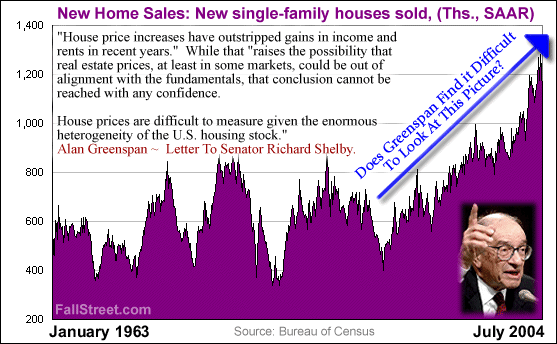
As for the above quote, made three weeks ago by Greenspan in response to Shelby’s question on the housing bubble - it is clear that Greenspan is not convinced that a housing bubble exists. This position not only opens the Fed boss up to attacks (see Baker, Wells), but also threatens to contradict a previous opinion offered by Greenspan.
“Existing home prices (as measured by the repeat-sales index) rose by 7 percent during 2002, and by a third during the past four years. Such a pace cannot reasonably be expected to be maintained.” Greenspan.
The above quote was made more than 17-months ago. Home prices (RSI) have increased by 9.36% over the last year (OFHEO). Can the current pace be reasonably expected to be maintained? Greenspan neglects to mention the issue of price today.
Another chart/quote highlights another untimely Greenspan prediction.
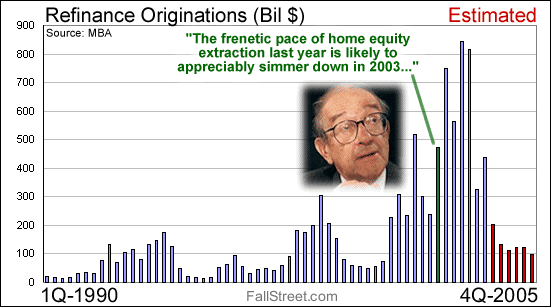 |
Without doubt Greenspan should be reiterating this prediction today, but he refuses to do so. The above quote from Greenspan is worth highlighting in full.
“In short, the frenetic pace of home equity extraction last year is likely to appreciably simmer down in 2003, possibly notably lessening support to household purchases of goods and services.” March 4, 2003 Remarks
Mr. Alan Greenspan made these comments in March 2003 – or right before an even faster pace of home equity extractions arrived. Why doesn’t Greenspan make similar comments today given that it is more obvious that pace of home equity extraction has collapsed? Because doing so would make his SSR theories less dreamy. For Greenspan, ‘blame it on oil’ keeps the SSR dream alive. .
Refi Ruminations
“Incidentally, the proportion of refinance to home purchase mortgages appears consistently higher in the data reported to us than in the data published elsewhere.” Greenspan
Exactly how large of an impact record mortgage refinancing have had on the U.S. economy is unknown. What is known is that the Fed – on multiple occasions – has offered an optimistic take about what will happen when home refinancing schemes slow down.
“Should rates rise, it is entirely possible that new and existing home sales would decline, leading to a lower level of realized capital gains on homes, a further narrowed refinance spread and, as a consequence, less overall home equity extraction. It is worth bearing in mind, however, that any sustained increase in rates presumably would occur only in the context of a more vigorous upturn in the pace of business activity, suggesting that the net effect on housing activity might be relatively limited.” March 4, 2003
Mirroring these comments, the Federal Reserve Bank of New York chimed in late last year.
“Interest rates will eventually rise and bring an end to the refinancing boom. But this uptick in rates will be the result of a pickup in the overall level of income in the economy; therefore, there will be other factors driving consumer spending. Thus, we do not expect a significant retrenchment in consumer spending once the refinancing boom comes to an end.” December 3, 2003 NYF
This just in: U.S. economic growth is moderating, the refi numbers are way down, the Fed wants to keep interest rates rising at a ‘measured pace’, and no ‘other factors’ have arrived to drive consumer spending higher. It is also worth pointing out that a spike in interest rates wasn’t required to seriously damage the home equity extraction mania – a simple flattening of mortgage rates has done the trick. Apparently no Fed member saw this coming and/or or admitted that the inevitable slow down in refinancings could arrive under today’s unwelcome circumstances.
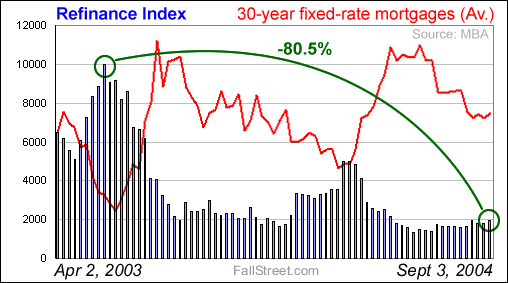 |
A refi discussion is hardly complete without mentioning corporate America. Part of the reason why companies are carrying historically high levels of cash today is because of Greenspan; not only has Greenspan’s economy fueled a profit recovery, but it has also permitted, in many cases, refinancing of corporate debt. In the case of the Dow, total interest expense is $5.5 billion lower per quarter today than it was in 1Q01. Annualized this represents $922 million in interest expense savings per year per Dow component.
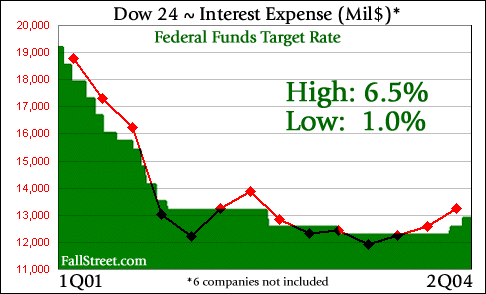 |
Suffice to say, while mortgage refinancings have kept the U.S. consumer spending, corporate refinancings have not had as big of an impact. Greenspan hopes that this soon changes.
The Fuzzy Relationship Between Rates of Interest
 |
Even as the Fed is raising its Federal Funds rate, market interest rates – on bonds and mortgages – continue to stay low or decline. For example, a 30-year fixed-rate mortgage will run you 5.75% today versus 5.81% to begin the year, and the 10-year Treasury is yielding 4.16% today versus 4.37% on January 2. Only a few weeks ago the 30Y-fix was at 6.32%, and the 10-year Treasury yield hit a high of 4.9%.
The start and stop action in the bond pits clearly indicates a lack of conviction on the part of traders. What it does not indicate, however, is what shape the yield curve will take in the coming months. The Fed deployed an aggressive monetary ease that spurred the housing market and facilitated carry trades, but the Fed will find it difficult to narrow the gap unless the jobs arrive. Most importantly, consumer prices and GDP do not mirror the historic feats of stimulus at the Fed. - Jobs do.
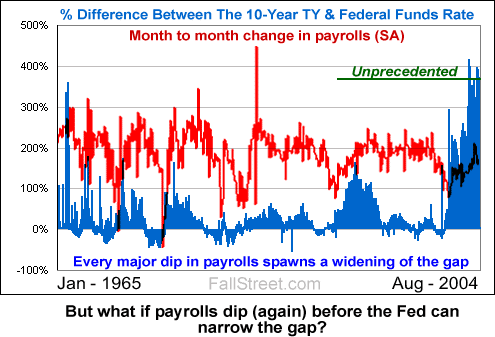 |
Conclusions
It is the hope of policy makers that U.S. interest rates – and foreign investor sentiment/debt demand that determines U.S. interest rates - can be adeptly managed in order to contain the U.S.’s housing bubble on a national scale. Moreover, it is the hope of policy makers that the current economic ‘soft patch’ is temporary; that businesses soon begin to deploy refinanced capital more aggressively. These are the hopes.
The reality is that the steep decline in mortgage refinancing activity is currently - and will likely continue to be for some time - a drag on consumer spending. Mr. Greenspan ignores the negative issue of home equity extraction while constantly extolling the benefits of the ever nearing SSR. It is as if Mr. Greenspan has stolen ‘The Scream’ and replaced it with a portrait of himself smiling. Smile and the world smiles back?
If it isn’t night it must be day. If you are not good you are bad. There is a Heaven and a Hell. If the U.S. economy is not in self-sustaining recovery how long will it take before recession becomes a self-fulfilling prophecy?
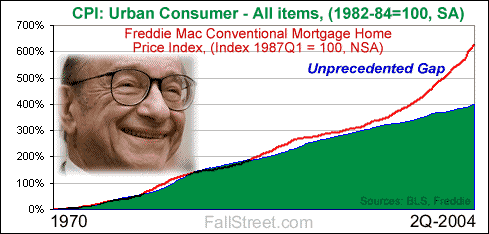 |
* Perhaps Greenspan’s ‘mixed’ comment was due to the fact that August 2004 had fewer selling days than August 2003?
BWillett@fallstreet.com